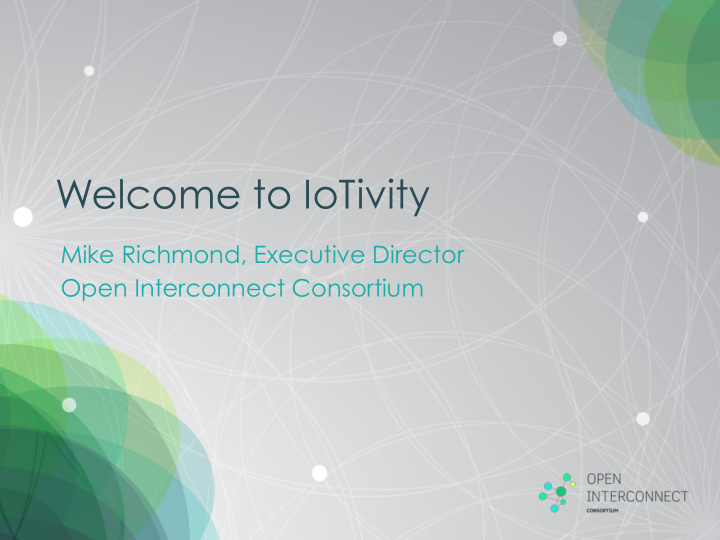



Welcome to IoTivity Mike Richmond, Executive Director Open Interconnect Consortium
Abstract This presentation will introduce today's track on IoTivity. The session will explain where the effort fits strategically among the various efforts to build standards and implementations of standards to implement the Internet of Things. It will also explain the IoTivity and OIC technical approach and why it is particularly well suited to large-scale IoT deployment.
The Challenge of IoT Communications The Internet of Things is currently evolving as “Isolated Islands of Things.” This severely limits the value of IoT. We can do better.
Addressing the Challenge of Communications OIC (the standard) and IoTivity (open source project) is making it easy for devices to connect and interoperate - regardless of vendor, OS, hardware, etc. þ = Interoperability Open Source Standards Certification Project
The Strategy for Building Device Interoperability IoT Device Interoperability Specification Open Source Project Certification þ • Provides a fast path to • Broad spectrum of • IP protection & market for developers industry leaders providing branding for certified and manufacturers guidance devices • Open source • Common • Certification = a device development promotes communications implementation as faster innovation via protocols, approaches defined in the community-driven for security and identity, specification and development and service-level released into the open protocols, object models source • Connectivity framework and developer APIs that abstracts complexity • Open specification that anyone can implement OIC is a global alliance to deliver "just-works" interoperability for developers, manufacturers and end-users through a specification and an open source project.
Sample of Current Members Diamond Platinum Gold Nonprofit
OIC/IoTivity IP Coverage– Best in the Industry OIC others Code contributed by a company is free to copy. yes yes Code contributed by a company comes with a license yes yes to use patents from that company with the code as long as certification is passed. Code contributed by a company comes with a license yes no to use patents from that company with the code even without certification (forking). Spec implemented in another programming language yes no and certified is licensed under patents of members. Patents from member companies who do not contribute yes no code are still licensed if needed to implement the spec. If code comes from one affiliate of a company, and the yes no patents are held by another affiliate or parent, the patents are still licensed. Summary information only. Complete policies are part of OIC membership documents. As always, consult your company’s attorney.
IoTivity Architecture Profiles Consumer Enterprise Automotive Education Industrial Health Layer 7: APPLICATION: APPLICATION: APPLICATION: Application Comm. Agent Comm. Agent Comm. Agent Layer 6: Framework APIs Presentation JSON, XML, HTTP, FTP, SMTP GATT-based ZCL Common Resource-Based Object Model Profiles SNMP, MQTT, Layer 5: CoAP Session Framework GATT Layer 4: Data Data Device UDP/DTLS GATT SMP Discovery Transport TCP/TLS Transmission Management Management ATT ZigBee PRO Security, Identity & Permissions L2CAP Layer 3: IP, ARP, DHCP Network HCI Layer 2: Data link LINK 802.11b/g/n 802.15.4 Layer 1: PHY Physical Interoperability comes from a common application framework for discovery, data transmission, data management, and device management. OIC is radio-independent.
What you don’t see in OIC Profiles Consumer Enterprise Automotive Education Industrial Health Layer 7: APPLICATION: APPLICATION: APPLICATION: Application Comm. Agent Comm. Agent Comm. Agent Layer 6: Framework APIs Presentation JSON, XML, HTTP, FTP, SMTP GATT-based ZCL Common Resource-Based Object Model Profiles SNMP, MQTT, Layer 5: CoAP Session Framework GATT Layer 4: Data Data Device UDP/DTLS GATT SMP Discovery Transport TCP/TLS Transmission Management Management ATT ZigBee PRO Security, Identity & Permissions L2CAP Layer 3: IP, ARP, DHCP Network HCI Layer 2: Data link LINK 802.11b/g/n 802.15.4 Layer 1: PHY Physical • Required gateway systems. • 1990s-style remote procedure calls. Why is this important?
IoT Can’t Deliver Potential Without Cloud source: http://m.eet.com/media/1174500/internet-of-things-lg.jpg
Successful IoT will build on Cloud- native Lessons from Mobile • Techniques developed for mobile click-bait have established the way to handle millions of devices with services integrated from dozens of companies. • Enterprise-style software and RPCs are scaling constraints. • Instead, IoT projects need technologies like node.js, microservices, containers and VMs. OIC/IoTivity are architected for scale deployment.
Participate! Become A Member! Join the Open Source Project Download the code and get • started Code is available under the • Apache v2.0 license Membership includes: Contribute code! • Gold Membership and above: http://www.IoTivity.org Certify spec compliant apps and • devices Use OIC branding • Benefit from patent cross-licensing • Get Educated on the Standard protection Go to the website to find out • Provide input in the standard • more and sign up to get development þ updates Platinum and above: Participate in working groups • http://openinterconnect.org/ • Diamond and above: newsletter/ One director appointed to the • board http://www.openinterconnect.org http://openinterconnect.org/join/ Device interoperability will change IoT as we know it today!
Summary OIC is a member-driven organization establishing transport- • independent standards for communication in IoT applications. OIC sponsors IoTivity, an open source project. • Between them, they offer the most robust, cloud-friendly • architecture with the best IP policies available. Learn more, and join us! • 11:30 IoTivity Primer 2:00 Security within IoTivity 3:00 Bringing Web Services to IoTivity 4:00 How to accelerate IoT Development with IoTivity Primitive services
Recommend
More recommend